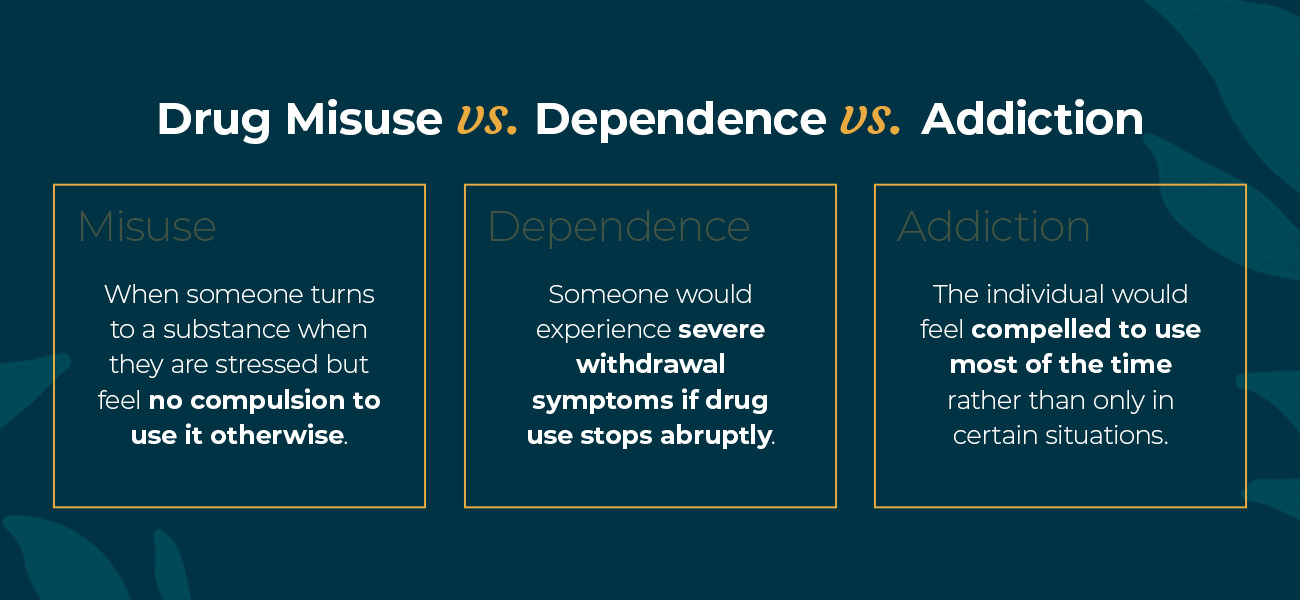Drug abuse and drug addiction

Many terms are used interchangeably when describing the use of substances, such as abuse and addiction. Because they usually have overlapping symptoms and causes, distinguishing between two diagnoses can be challenging. But for those preparing to recover and seek treatment, understanding the differences between drug abuse and drug use will help you understand the next key step.
Understand outpatient treatment
What is drug abuse?
Drug abuse is the use of illegal or legal substances in a different way than the intended purpose or amount considered excessive. For example, a person may exceed the amount of prescription dose or use someone else’s prescription. Abuse of substances can also include alcohol and illicit drugs such as heroin and methamphetamine.
In many cases, substances are abused for experimental and recreational reasons. Due to curiosity, they try alcohol and other drugs (AOD) and continue to use it because they like to be affected. Sometimes, substance abuse is associated with a specific challenge or situation. People may turn to AOD to alleviate negative symptoms of medical conditions, relieve stress, avoid reality and even seek creative inspiration. Certain religious rituals also involve drug use.
Not everyone who uses AOD is addicted, but regular abuse often leads to addiction. Ultimately, everyone’s body and brain react differently – some may use a substance for a short period of time and become addicted quickly, while others may continue to abuse the substance without falling into addiction.
Even if someone is not addicted, any substance abuse can be at a serious risk. Through decades of research and imaging scans, repeated abuse of drug abuse can lead to physical changes in the brain in areas that affect judgment, decision-making, memory and behavioral control. There are also social and legal consequences, such as:
- Frequently occurring legal and financial difficulties.
- Relationship issues.
- Work, school or home problems.
- Endangering one’s own safety or the safety of others.
Signs of drug abuse
If you are worried that you or your loved ones are misusing substances, recognizing these signs early can be a key step in seeking treatment:
- Sleep disorders
- Change in appetite
- Red eyes
- Runny nose
- Shivering hands or sweaty palms
- Poor hygiene
- ADHD or irregular heartbeat
- Chin and twitching nose
Explore more detox resources
What is drug addiction?
Drug addiction is a complex chronic disease that leads to intense desires that lead to forced pursuit and use of AOD. This disease is considered a brain disease because it involves the function of the brain, especially in the areas of regulating rewards, stress and self-control.
Addiction is by no means a moral failure or a lack of willpower, and reducing associated stigma is essential to encourage treatment. Because drug seeking is caused by habit rather than conscious and rational decisions, those experiencing addiction may continue to use it even when they are aware of the adverse effects. Some other characteristics of drug addiction include:
- Even if someone wants to, he feels incompetent to stop.
- Cannot operate in a productive way.
- Recurrence frequently.
As addiction progresses, individuals may develop a kind of tolerance, meaning their brain or body responds less to substances over time. As a result, they seek larger or more frequent doses. Drug tolerance can accelerate the negative effects of drug use, such as increasing the likelihood of dependency. Using larger doses also gives a higher risk of unexpected overdose.
Signs of drug use
Here are some signs that you or your loved one may be getting addicted:
- Changes in appetite, weight gain or weight loss
- Sleep interruption
- Lethargy and fatigue
- Red eyes or precise students
- Tremor
- Lack of personal hygiene
- Poor physical coordination
Understand outpatient treatment
Drug Abuse and Addiction: What’s the Difference?

In addition to physical signs, abuse and addiction can also lead to personal irritability, feeling paranoid, secret, and constantly showing dishonest behavior. They may change friends, become oversensitive, and be disconnected from family activities.
Despite their similarities, substance abuse and drug use are considered two different diagnoses. Substance abuse is a pattern of harmful use, while addiction is a disease that causes changes in the brain, leading to cravings and compulsive behaviors. Drugs of abuse are often considered a mild form of harmful drug use, and addiction is even more severe. As mentioned earlier, substances can be abused without causing addiction, but chronic substance abuse often leads to addiction.
Let’s take a closer look at the differences between substance abuse and addiction:
- Control level: Those engaged in drug abuse often still have some degree of control over their lives. Addiction is characterized by a lack of control – individuals cannot stop using substances despite their willingness.
- Consequences of use: People who experience addiction often fail to fulfill their daily obligations at work, school and family. This negative consequence can be serious and lasting, but the individual cannot stop or reduce use. Drug abuse can also often lead to negative effects on the individual. However, they may not experience as much material interference and may be able to limit or abstain from using AOD.
- Reason for use: In the context of substance abuse, substance use is driven by experimental or situational factors. For those experiencing addiction, the brain’s reward system is destroyed, resulting in forced use of substances to trigger these reward circuits.
- Appropriate treatment: While counseling or support groups for the early stages of substance abuse may be sufficient, more severe addiction often requires hospitalization medication.
Drug abuse and dependence and addiction
Although “addiction” is often used interchangeably with “material dependence”, these are also two separate concepts. Dependence is that when a person’s body begins to rely on AOD, many medications may occur, including prescription medications taken as directed by a doctor. If medication use is abruptly stopped, people with dependencies experience severe withdrawal symptoms.
Unlike addiction, dependence is not a disease that involves difficult to control one’s behavior. Another difference is that if a person depends on substance, gradually cutting it out can help them stop using it. However, this method is unavailable in the context of addiction. A person can also rely on drugs without experiencing addiction and vice versa. People who encounter addiction and dependency often require medically assisted detox as part of their treatment.
Mental dependence is another possibility. This is when someone relies on AOD to help them cope with emotional distress. For example, someone may turn to substances when stressed, but otherwise they will not force it. This person will abuse drugs, but may not fall into addiction. With addiction, individuals are forced to use in most cases rather than in some cases.
Diagnosing the future of drug use
Many mental health professionals and addiction experts no longer distinguish between abuse and addiction. In the American Psychiatric Association’s Manual on Diagnostic and Statistical Mental Disorders (DSM), both substance abuse and addiction are known as drug use disorders (SUD). SUD is defined as a complex condition that, despite the adverse consequences, repetitive and forced use of substances by individuals. They include:
- Alcohol use disorder.
- Illegal drug use disorder.
- Disorders in prescription medication use.
Today, addiction is defined based on varying degrees of severity, characterized by a person’s relationship with the drug – SUD may be mild, moderate, or severe. More than 12 Americans are affected by SUD to varying degrees. Although the distinction between terms such as “abuse” and “addiction” is outdated, the correct diagnosis remains critical to finding the right treatment plan to help an individual find success.
Addiction is both a mental illness and a disease that is often occupied with other diseases such as anxiety, depression, mood disorders and trauma. Going forward, you can expect to see addiction professionals integrate more neurology, biology, and mental health into the diagnostic process. A better understanding of the complexity of addiction allows medical professionals to address the wider diagnosis of the most effective treatment.
In addition, healthcare reforms and evolving policies regarding addiction treatment make it easier for clients to find the care they need. With more health care services, more and more people are finding accurate diagnosis of addiction and concurrent conditions and obtaining personalized treatment plans that help them succeed.
Understand outpatient treatment
Why trust us with SUD therapy?
At Diamond House Detox, we understand that addiction is a chronic disease that affects everyone differently. That’s why our experts offer personalized treatments with varying degrees of bubbles to ensure you or your loved ones get the necessary help. Once we understand the client and its situation, we will explore a variety of options available, including residential treatment, sober residence and outpatient care.
Our dual diagnostic treatment takes a holistic approach – we are committed to addressing the entire person to support lasting recovery. Our care includes addressing guests’ medication use, mental health, as well as medical, psychological and spiritual needs. In addition to providing guidance and nurturing but structured environments, we also offer individual therapies, group consultations, medical assisted detox and accompanying medical services.
Treatment required to detoxify with Diamond House
Regardless of its condition, the impact of SUD can have a lasting impact on many areas of a person’s life. However, determining the severity of drug use by you or your loved one makes it easier for you to find successful treatments. Our expertise enables us to assess your personal needs so we can provide you with the best care.
To learn more about our Northern California plant, please contact us today.





